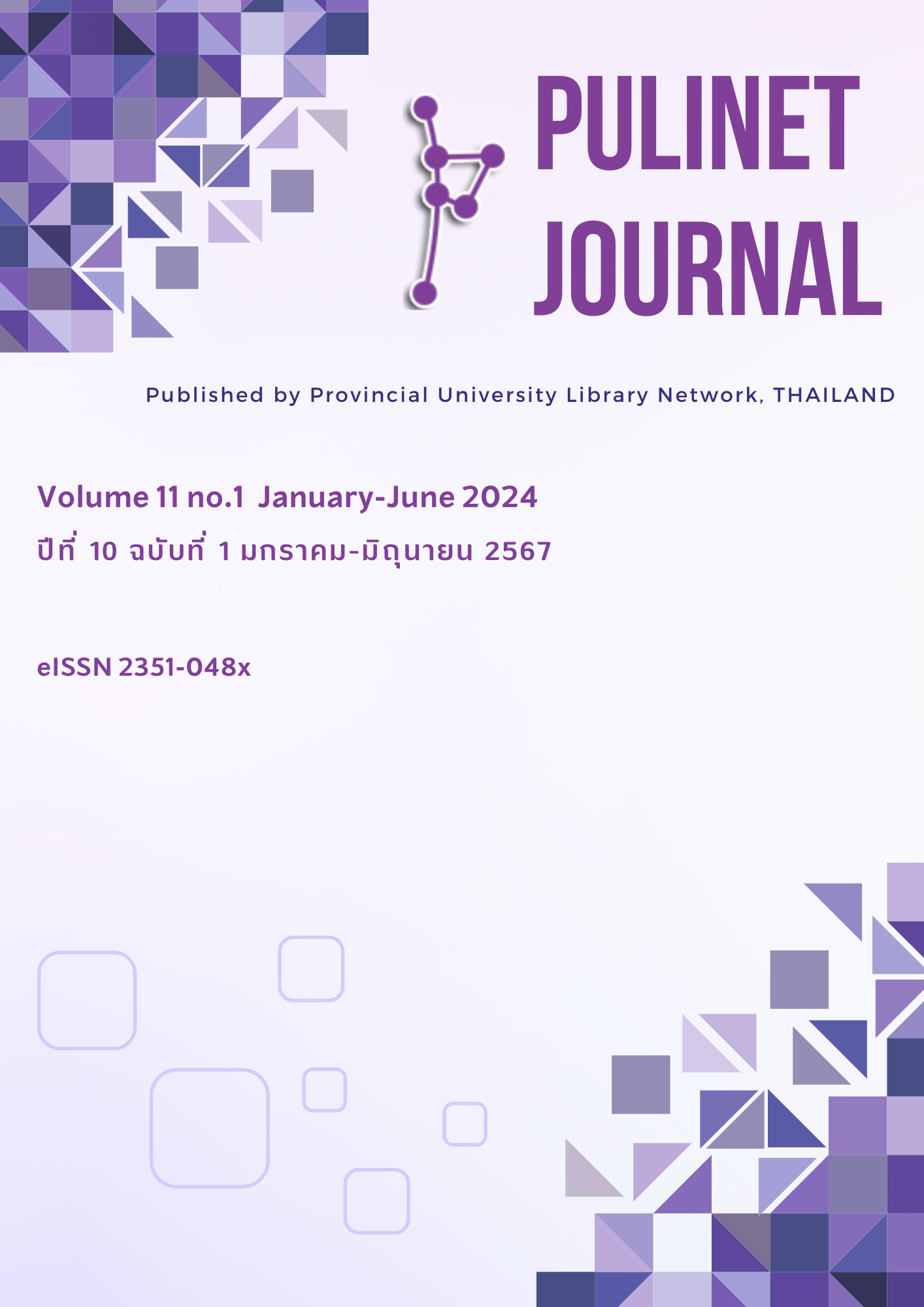การวิเคราะห์ความคุ้มค่าของการใช้ทรัพยากรสารสนเทศ ตามแนวคิดทฤษฎีทางเศรษฐศาสตร์
Main Article Content
บทคัดย่อ
งานวิจัยนี้มีวัตถุประสงค์เพื่อวิเคราะห์ความคุ้มค่าของการใช้ทรัพยากรสารสนเทศประเภทสิ่งพิมพ์และดิจิทัล ด้านต้นทุน จุดคุ้มทุน ต้นทุน-ผลประโยชน์ มูลค่าปัจจุบันสุทธิ ผลตอบแทนภายใน งบประมาณการจัดซื้อกับอัตราการใช้และประสิทธิผลจากการใช้ทรัพยากรสารสนเทศของสำนักบรรณสารสนเทศ มหาวิทยาลัยสุโขทัยธรรมาธิราช โดยวิเคราะห์ข้อมูลระหว่างปีงบประมาณ พ.ศ. 2563-2565 ใช้แนวคิดการวิเคราะห์ความคุ้มค่าทางการเงินจากมูลค่าปัจจุบันสุทธิ (NPV) อัตราผลตอบแทนภายในของโครงการ (IRR) อัตราส่วนผลประโยชน์ต่อเงินลงทุน (B/C) และงบประมาณกับอัตราการใช้ ผลการวิจัย พบว่าทรัพยากรสารสนเทศดิจิทัล มีค่า (อัตราส่วนผลประโยชน์ต่อเงินลงทุน B/C = 2.51) มีค่า (อัตราผลตอบแทนภายในของโครงการ IRR = 81) มีค่าใช้จ่ายต่อครั้งของการใช้ เท่ากับ 60.79 บาท ส่วนทรัพยากรสารสนเทศสิ่งพิมพ์ มีค่า (B/C = 0.93) มีค่า (อัตราผลตอบแทนภายในของโครงการ IRR = -56) มีค่าใช้จ่ายต่อครั้งของการใช้ เท่ากับ 90 บาท สรุปว่า ทรัพยากรสารสนเทศดิจิทัลมีความคุ้มค่าทางการเงินมากที่สุด ด้านประสิทธิผล คือ ความคุ้มค่าที่ไม่ใช่ตัวเงิน เป็นความรู้ที่ได้จากการใช้ทรัพยากรสารสนเทศที่ผู้ใช้บริการได้รับเพื่อนำไปใช้ประโยชน์ตามวัตถุประสงค์ที่ต้องการ ดังนั้น ผลการวิจัยนี้สามารถนำไปประยุกต์ใช้ในการจัดสรรทรัพยากรสารสนเทศให้เกิดความคุ้มค่าทางการเงินและการใช้งานได้อย่างมีประสิทธิภาพ
Article Details

อนุญาตภายใต้เงื่อนไข Creative Commons Attribution-NonCommercial-NoDerivatives 4.0 International License.
เอกสารอ้างอิง
กระทรวงศึกษาธิการ. (2559). แผนพัฒนาการศึกษาของกระทรวงศึกษาธิการฉบับที่สิบเอ็ด พ.ศ. 2555-2559. กระทรวงศึกษาธิการ.
กัญญาณัฏฐ์ สาธกธรณ์ธันย์. (2563). การวิเคราะห์ต้นทุนและความคุ้มค่าคุ้มทุนของการจัดการศึกษาของคณะพยาบาลศาสตร์ มหาวิทยาลัยนเรศวร. วารสารวิจัยสุขภาพและการพยาบาล, 36(1), 39-54. https://he01.tci-thaijo.org/index.php/bcnbangkok/article/view/242137/164677
ฉันท์ชนก ฝนเชย, ตรีทิพย์ ขันธพร, และ ปภัสรา ฝึกศิลป์. (2562). การศึกษาเกี่ยวกับทัศนคติการใช้ทรัพยากรสารสนเทศดิจิทัลของหอสมุดแห่งชาติ. https://info-science.dusit.ac.th/student/pdf/AcademicWork/2562-ISLIS-SDU-06.pdf
ดวงใจ กาญจนศิลป์ และ วิไลลักษณ์ อินมีศร. (2556). ความคุ้มค่าของทรัพยากรสารสนเทศของศูนย์บรรณสารและสื่อการศึกษา มหาวิทยาลัยเทคโนโลยีสุรนารี. http://sutir.sut.ac.th:8080/sutir/bitstream/123456789/4156/1/55-02-05.pdf
ธนะพันธุ์ การคนซื่อ. (2566). การศึกษาปัจจัยที่ส่งเสริมการสอนการรู้สารสนเทศรูปแบบออนไลน์. ใน ก้าวต่อไปของการพลิกโฉมห้องสมุดภายใต้ความผันผวนของโลกยุคใหม่. การประชุมวิชาการระดับชาติ PULINET ครั้งที่ 13. (น. 337-351). Pulinet. https://drive.google.com/file/d/1P4cC9Xtmmc3td7_xjLvXxE9qTBoFZOln/view
บุณยาพร ภู่ทอง. (2561). เศรษฐศาสตร์ธุรกิจ. https://elcls.ssru.ac.th/bunyaporn_ph/pluginfile.php/126/mod_resource/content/1/ตำราเศรษฐศาสตร์-----ภาษาไทย.pdf
ปรีดี ปลื้มสำราญ และ พงศกร กุกันยา. (2564). ห้องสมุดกับภาวะความปรกติใหม่ในประเทศไทย. วารสารการอ่านสมาคมการอ่านแห่งประเทศไทย, 25(1). 1-26. https://so01.tci-thaijo.org/index.php/rdj/article/view/244966/167766
พิชามญชุ์ กาหลง. (2564). แนวทางการประเมินความคุ้มค่าของโครงการจัดซื้อจัดจ้างภาครัฐกรณีจ้างก่อสร้าง. วารสารวิชาการไทยวิจัยและการจัดการ, 46(2), 46-60. https://so05.tci-thaijo.org/index.php/TRDMJOPOlSU/article/view/254523
มหาวิทยาลัยสุโขทัยธรรมาธิราช. กองแผนงาน (2565). แผนปรับแต่งแปลงโฉมมหาวิทยาลัยสุโขทัยธรรมาธิราช พ.ศ. 2565-2569. https://www.stou.ac.th/offices/opr/planning/pl_main_v2.1/up/(O4)%20%20Reinventing%20Plan%202565-2569.pdf
วสันต์ ภูวภัทรพร. (ม.ป.ป.). เอกสารประกอบการบรรยาย ECO 2104 ประวัติลัทธิเศรษฐกิจ. http://www.eco.ru.ac.th/images/document/studentinfo/eco2104.pdf
สำนักงานเลขาธิการสภาการศึกษา. (2560). แผนการศึกษาแห่งชาติ พ.ศ. 2560-2579. สำนักงานเลขาธิการสภาการศึกษา. https://backoffice.onec.go.th/uploads/Book/1540-file.pdf
สำนักบรรณสารสนเทศ. (2556, ตุลาคม 18). สรุปข้อมูลสถิติการใช้และงบประมาณการใช้ทรัพยากรสารสนเทศ ปีงบประมาณ พ.ศ.2563-2565. www.stou.ac.th/link/wJvDd
Ehrhardt, Michael C., & Brigham, Eugene F. (2011, May 31). Financial Management: Theory and Practice (13th ed.). https://handoutset.com/wp-content/uploads/2022/03/Financial-Management-Theory-and-Practice-13th-Edition-by-Eugene-F.-Brigham-Michael-C.-Ehrhardt.pdf


